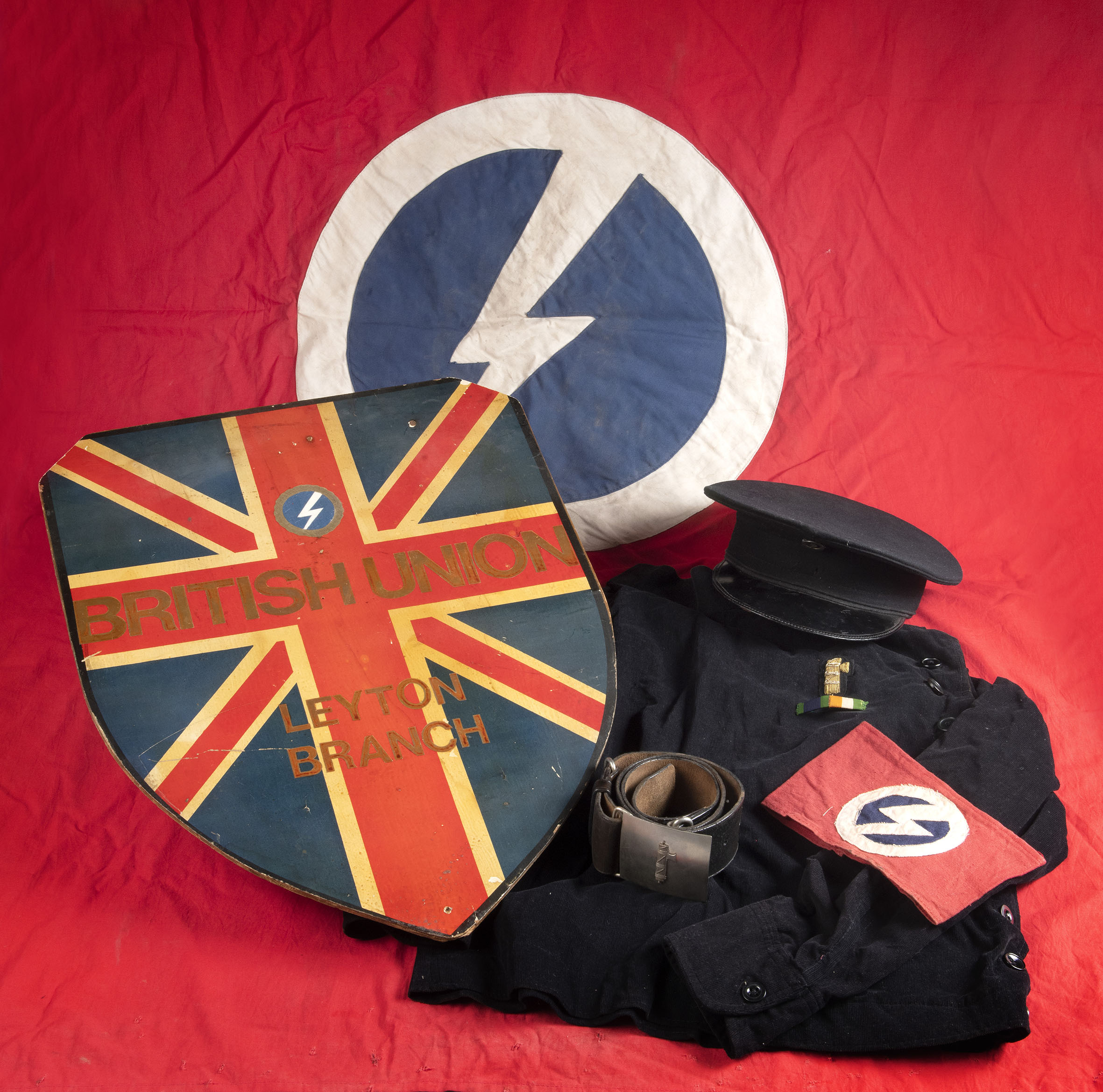British Union of Fascists Grouping
A collection of artifacts from the British Union of Fascists (BUF) including a flag from HMP Holloway, the Leyton branch headquarters plaque, regulation peaked cap from the paramilitary Fascist Defence Force, and an early officer’s tunic paired with a BUF armband and belt.
From the earliest days of the BUF, its active male members wore the iconic black shirt as their uniform, modelled on Sir Oswald Mosley’s fencing tunic. Mosley stated that the black shirt was worn because the color black best expressed the “iron determination of Fascism in the face of red anarchy”. By eliminating distinctions of dress, it also contributed to the breaking down of class barriers within the movement. Aside from ideological purposes, the tunic proved practical in the street fights against leftist provocateurs as the garment offered little for an opponent to get a grip on. They were worn until the banning of political uniforms under the Public Order Act 1936 and the subsequent incarceration of BUF members as political prisoners.
This particular BUF officer’s tunic is the lined velvet kind, embroidered with a gilt wire fasces worn by officers, replacing the usual brass badge from the years 1933-1935. Attached to the tunic are ribbons for the Boer War King’s Medal Ribbon awarded in 1901 and an India General Service Medal awarded in 1909. Based off the fact that one had to be at least 18 years of age to join the British army in 1901 and that the bullion fasces badge was only introduced in 1933 to replace this embroidered type, the wearer of this uniform is inferred to have been at least 52 years of age.
The peaked cap seen here retains its original metal flash and circle insignia, and was worn by members of the Fascist Defence Force, the paramilitary section of the BUF.
The BUF Leyton Branch headquarters shield was displayed on the interior and exterior of the headquarters for the 1937 coronation of King George VI and Queen Elizabeth. Measuring 61cm x 46.5cm, these shields were often disposed of after the coronation, making them exceptionally rare.
Flag serving as the backdrop measures 191cm x 107cm and is stamped “B.U.F. HOLLOWAY” in blank ink, suggesting it to be from HM Prison Holloway where Mosley and many other BUF members and supporters were interned. On May 23rd, 1940, the BUF was banned outright by the government via Defence Regulation 18B and Mosley, along with 740 other fascists, were arbitrarily interned for much of the Second World War. Sir Oswald and Lady Mosley were released in November 1943 and greeted by mass public protest, while other BUF leaders including Alexander Raven Thomson (1899–1955), the movement’s main ideologue and the author of The Coming Corporate State (1937), waited until 1944 for their release. After the war, Mosley made several unsuccessful attempts to return to politics such as via the Union Movement and calls for his version of a united Europe, but enjoyed limited success.
Free shipping on orders over $50!
- Satisfaction Guaranteed
- No Hassle Refunds
- Secure Payments
A collection of artifacts from the British Union of Fascists (BUF) including a flag from HMP Holloway, the Leyton branch headquarters plaque, regulation peaked cap from the paramilitary Fascist Defence Force, and an early officer’s tunic paired with a BUF armband and belt.
From the earliest days of the BUF, its active male members wore the iconic black shirt as their uniform, modelled on Sir Oswald Mosley’s fencing tunic. Mosley stated that the black shirt was worn because the color black best expressed the “iron determination of Fascism in the face of red anarchy”. By eliminating distinctions of dress, it also contributed to the breaking down of class barriers within the movement. Aside from ideological purposes, the tunic proved practical in the street fights against leftist provocateurs as the garment offered little for an opponent to get a grip on. They were worn until the banning of political uniforms under the Public Order Act 1936 and the subsequent incarceration of BUF members as political prisoners.
This particular BUF officer’s tunic is the lined velvet kind, embroidered with a gilt wire fasces worn by officers, replacing the usual brass badge from the years 1933-1935. Attached to the tunic are ribbons for the Boer War King’s Medal Ribbon awarded in 1901 and an India General Service Medal awarded in 1909. Based off the fact that one had to be at least 18 years of age to join the British army in 1901 and that the bullion fasces badge was only introduced in 1933 to replace this embroidered type, the wearer of this uniform is inferred to have been at least 52 years of age.
The peaked cap seen here retains its original metal flash and circle insignia, and was worn by members of the Fascist Defence Force, the paramilitary section of the BUF.
The BUF Leyton Branch headquarters shield was displayed on the interior and exterior of the headquarters for the 1937 coronation of King George VI and Queen Elizabeth. Measuring 61cm x 46.5cm, these shields were often disposed of after the coronation, making them exceptionally rare.
Flag serving as the backdrop measures 191cm x 107cm and is stamped “B.U.F. HOLLOWAY” in blank ink, suggesting it to be from HM Prison Holloway where Mosley and many other BUF members and supporters were interned. On May 23rd, 1940, the BUF was banned outright by the government via Defence Regulation 18B and Mosley, along with 740 other fascists, were arbitrarily interned for much of the Second World War. Sir Oswald and Lady Mosley were released in November 1943 and greeted by mass public protest, while other BUF leaders including Alexander Raven Thomson (1899–1955), the movement’s main ideologue and the author of The Coming Corporate State (1937), waited until 1944 for their release. After the war, Mosley made several unsuccessful attempts to return to politics such as via the Union Movement and calls for his version of a united Europe, but enjoyed limited success.




